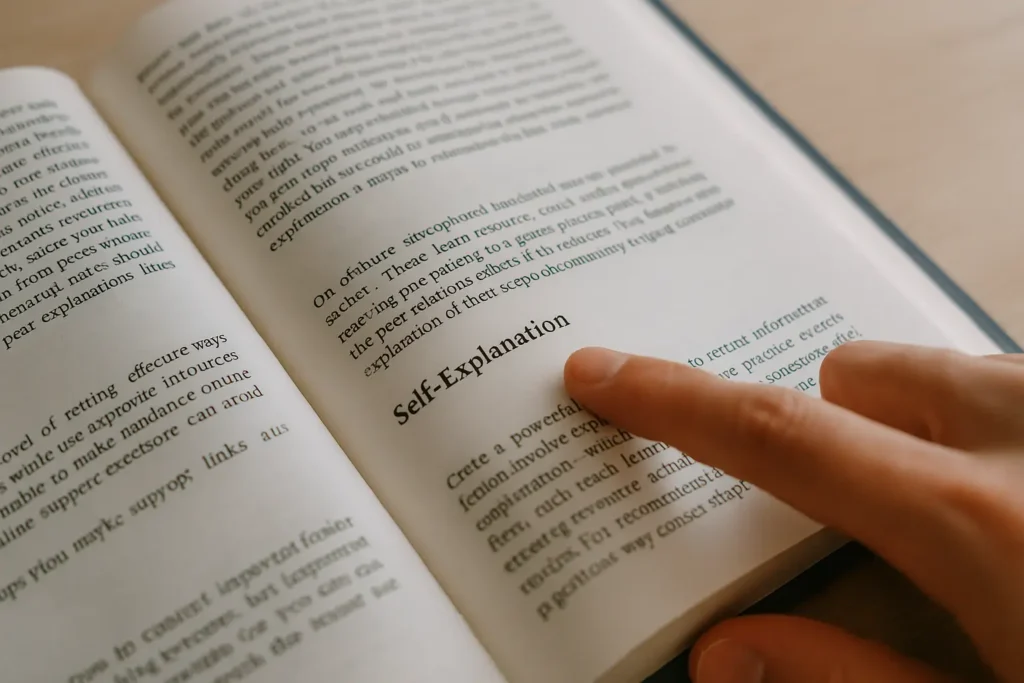
In the world of competitive exams, it’s not enough to simply read, watch classes, or solve questions. True learning happens when you’re able to take what you’ve studied and explain it clearly — to yourself or to someone else. This is the core idea behind the self-explanation technique, a powerful and research-backed method that can significantly enhance understanding and memory retention.
Self-explanation is exactly what it sounds like: you explain the content to yourself using your own words, thoughts, and logic. Instead of passively reading or underlining, you actively reconstruct the information in your mind — as if you were teaching the subject to someone who doesn’t know it. This forces you to process the material more deeply, identify gaps in your understanding, and build stronger mental connections between concepts.
While the technique may seem simple at first, its benefits are profound. Studies in cognitive psychology have shown that self-explanation improves comprehension, problem-solving ability, and long-term retention across various subjects. For candidates preparing for complex exams — where depth of understanding often makes the difference between passing and failing — it can become a game-changing habit.
Why Self-Explanation Works
The act of explaining something, even silently in your own head, activates several cognitive processes at once. First, it requires you to retrieve the information from memory, which strengthens neural connections and helps move knowledge from short-term to long-term memory. Then, as you organize your thoughts, you engage in elaboration — linking new content to what you already know.
This deeper engagement helps you clarify the relationships between ideas, spot contradictions, and resolve confusion. It also encourages metacognition — the ability to think about your own thinking. When you’re forced to articulate what you understand, you quickly become aware of what you don’t. And that awareness allows you to go back and review the content more precisely.
In contrast, passive techniques like re-reading, highlighting, or even watching a lecture can give the illusion of learning without the mental effort needed for true comprehension. Self-explanation eliminates that false sense of familiarity. You’re not just seeing the information — you’re actively rebuilding it in your mind.
How to Start Using the Technique in Practice
Applying self-explanation doesn’t require any special tools. You can begin with the content you’re already studying. After reading a section of a textbook, watching a class, or solving a set of questions, pause and try to explain the material aloud or in writing, without looking at the source.
Ask yourself questions like:
- Why does this concept work this way?
- How does it connect to what I learned earlier?
- Can I give a real-life example or analogy?
- What would I say to someone who knows nothing about this?
The goal is not to repeat the content word-for-word, but to reconstruct it with your own reasoning. Even if you make mistakes during the explanation, that’s part of the learning process. Those mistakes reveal weak points and force your brain to correct and reinforce the right logic.
If you feel uncomfortable speaking out loud, you can write your explanations in a notebook or record short voice memos for review. The most important part is to be intentional. It’s not about reviewing material — it’s about processing it actively.
When and Where to Use Self-Explanation

This technique is flexible and can be used at different points in your study routine. One effective time is immediately after learning a new topic. Instead of jumping to the next section, take a few minutes to explain what you just learned. This helps consolidate the information while it’s still fresh.
Another great moment to apply self-explanation is during review sessions. When revisiting content after a few days or weeks, don’t just re-read your notes. Try to recall and explain the concepts from memory before checking the answers. This strengthens retrieval skills and deepens your understanding of the material.
You can also use self-explanation after solving questions — especially the ones you got wrong. Instead of just reading the right answer, explain why your answer was incorrect and why the correct one makes sense. This transforms errors into learning opportunities and prevents you from repeating the same mistake later.
Common Challenges and How to Overcome Them
At first, self-explanation might feel slow, awkward, or even frustrating. That’s normal. Many students are used to passive study methods that feel more comfortable but offer less return. Pushing your brain to explain things requires effort — and that’s a good sign. It means you’re actually learning.
One common obstacle is the fear of not knowing how to explain properly. You might think, “What if I say it wrong?” But remember, the purpose is not perfection. It’s reflection. Even flawed explanations help expose what you need to revisit or clarify. Over time, your ability to explain improves — and that’s a clear indicator of progress.
Another issue is time pressure. Some candidates believe that self-explanation “takes too long” and slows down their study plan. While it’s true that this method can make your sessions more intense, it also makes them more efficient. Ten minutes of active explanation can teach you more than thirty minutes of passive reading.
Combining Self-Explanation With Other Techniques
One of the strengths of self-explanation is that it integrates well with other evidence-based strategies. For instance, you can combine it with active recall — by asking yourself a question, answering from memory, and then explaining the reasoning behind your answer.
It also pairs well with spaced repetition. During review cycles, use self-explanation to reinforce older material and make connections with newer topics. You can even create flashcards with prompts that force you to explain a concept, rather than just recognize a definition.
If you study in a group, try “peer explanation,” where each person takes turns explaining topics to the others. Teaching is one of the most effective forms of self-explanation, as it pushes you to organize your thoughts clearly and answer unexpected questions.
Final Thoughts: Turn Understanding Into Mastery
In competitive exams, especially those with dense and detailed content, it’s not enough to just memorize. You need to understand deeply and apply confidently — and self-explanation helps you do exactly that. It builds stronger memory, reveals gaps, and transforms your study sessions into moments of real growth.
Instead of asking, “Did I study this topic?” start asking, “Can I explain it clearly without looking?” That shift in mindset is what separates average candidates from top performers. When you can teach the subject to yourself, you know you’re ready for the exam.
So don’t just read. Don’t just watch. Explain. To yourself. Out loud. In your words. That’s how you consolidate what you study — and how you take your preparation to the next level.